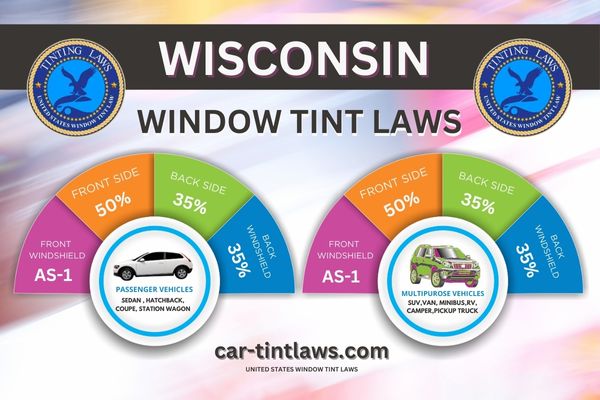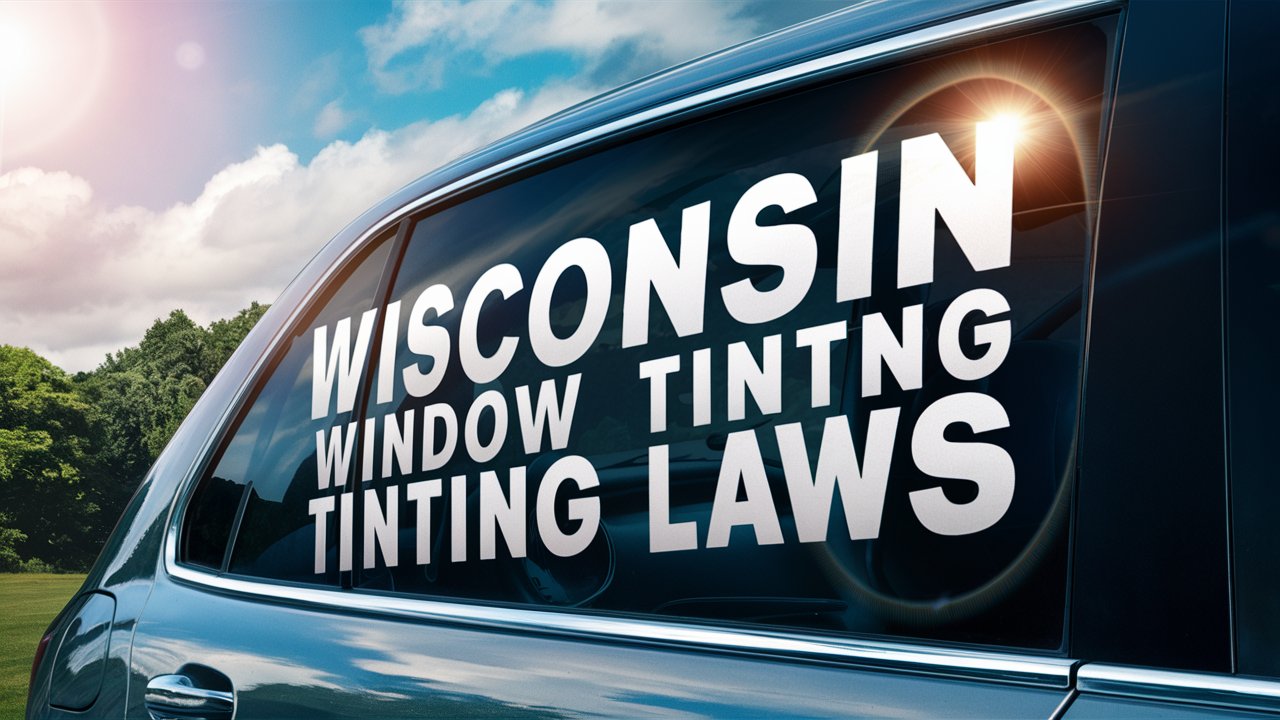When considering window tinting for your vehicle in Wisconsin, it’s important to understand the specific regulations to guarantee compliance and avoid fines.
You might be surprised to learn that the state has distinct rules for sedans versus SUVs and vans, particularly regarding the allowable darkness and reflectiveness of the tint.
Did you know that front side windows must let through more than 50% of light? There are also medical exemptions that could apply to you. So, how do these laws balance safety with personal preference, and what should you watch out for?
Window Tint Darkness in Wisconsin
When considering window tint darkness in Wisconsin, you should know that for sedans, the law permits a tint darkness of 35% on back side windows and rear windshields, while front side windows must allow over 50% light transmission.
SUVs and vans follow similar rules, maintaining these specific percentages to comply with regulations. Remember, violating these rules can result in fines and penalties, so it’s essential to adhere to these guidelines for road safety.
Tint darkness for sedans:
- Windshield: Non-reflective tint is allowed on the top 6 inches of the windshield.
- Front Side windows: Must have a tint darkness of 50% or more.
- Back Side windows: Must have a tint darkness of 35% or higher.
- Rear Window: Must have a tint darkness of 35% or higher.
Tint darkness for SUV and Vans:
- Windshield: Non-reflective tint is allowed on the top 6 inches of the windshield.
- Front Side windows: Must allow more than 50% of light in.
- Back Side windows: Must allow more than 35% of light in.
- Rear window: Must allow more than 35% of light in.
Window Tint Reflection in Wisconsin
When considering window tint reflection in Wisconsin, one must bear in mind that it must not exceed 20% reflectivity on both front and back windows for all vehicle types.
This regulation applies to sedans, SUVs, and vans alike, ensuring uniformity across different vehicles.
Adhering to these limits helps maintain safety standards by preventing excessive glare that could blind other drivers.
Tint reflection for sedans:
- Front Side windows: Must not reflect more than 20% of light.
- Back Side windows: Must not reflect more than 20% of light.
Tint reflection for SUV and vans:
- Windshield: Only non-reflective tint is permissible.
- Front Side windows: Must allow more than 50% light transmission.
- Back Side windows: Must allow over 35% light transmission.
- Rear windows: Should permit more than 35% light transmission.
Other Wisconsin window tint rules and regulations
- Side Mirrors: No restrictions.
- Restricted Colors: In Wisconsin all tint colors are permitted.
- Certificates: Manufacturers of film need to certify the film they sell in the state. Ask your dealer if they are using certified film.
- Stickers: There is no requirement for a certified sticker to indicate legal tinting in Wisconsin.
- Medical Exceptions: Wisconsin allows medical exemptions for special tint with a written statement from a physician. Consult Wisconsin state law for specific terms of the exemption.
- Penalties: Violation tickets for tint can vary in Wisconsin, always check with local authorities for potential costs.

Medical Exemptions for Window Tint Rules in Wisconsin
You can request a medical exception for window tinting in Wisconsin with a written statement from your physician.
This exception allows you to have a special tint for your front-side windows, provided the visible light transmission (VLT) is not below 35%.
The Wisconsin tint regulations accommodate individuals with special tint needs due to medical conditions, guaranteeing that they can drive comfortably and safely.
To qualify for a medical exception, your physician must provide a written statement detailing the necessity of the window tint for your condition.
This document is essential and must be kept in your vehicle at all times to ensure compliance with Wisconsin’s window tint rules. It’s your responsibility to present this statement if questioned by law enforcement.
While these medical exceptions are helpful, it’s important to verify all details with local and state authorities before applying the tint to your windows.
Regulations can change, and staying informed will help you avoid any legal issues. By understanding and adhering to the window tint rules, you can take advantage of the medical exceptions available in Wisconsin, guaranteeing that your special tint needs are met without violating state laws.
Wisconsin Window Tint Ticket Cost
While medical exemptions provide some flexibility, understanding the cost and consequences of violating Wisconsin’s window tint laws is essential for all drivers.
If you’re caught with an illegal window tint, the window tint ticket cost in Wisconsin can be up to $100 for a first offense.
This might seem like a minor inconvenience, but repeated violations can add up, impacting your wallet and your driving record.
In addition to the fine, you may receive a fix-it ticket, which requires you to correct the tint to meet legal window tint standards.
This means you’ll have to spend additional time and money making sure your vehicle complies with Wisconsin Window Tinting Laws.
Compliance with tint regulations is vital for road safety, as it guarantees that drivers have adequate visibility, reducing the risk of accidents.
Medical exemptions for darker tints do exist, but they require a letter from a licensed physician.
Law enforcement takes these regulations seriously to maintain driver safety and visibility.
Ensuring your vehicle meets the legal window tint requirements not only helps you avoid fines but also contributes to safer roads for everyone. By adhering to these laws, you become part of a community dedicated to road safety and compliance.
Wisconsin State Overview
In this overview, you’ll learn about the specific tint percentage limits for different vehicle windows, how these regulations are enforced, and the penalties for non-compliance.
We’ll also explore the exemptions and special cases allowed under Wisconsin law, including medical reasons for darker tints. Understanding these points will help guarantee your vehicle meets state requirements and avoids legal issues.
Tint Percentage Limits
For Wisconsin drivers, understanding the specific tint percentage limits is important to make certain your vehicle complies with state laws.
According to state law, the front side windows must allow over 50% light transmission.
This means your tint can’t be too dark, guaranteeing good visibility for you and others on the road.
For the rear side windows and rear windshield, the limit is over 35% light transmission. Whether your tint is temporary or permanent, these limits are essential for maintaining safety and legality.
Medical exemptions are available if you need darker tints due to health reasons. You’ll need a letter from a licensed physician to qualify.
This recommendation applies to make sure that even with darker tints, your vehicle remains in good working order and compliant with state laws.
Wisconsin’s laws also dictate acceptable tint colors, so be sure yours align with these regulations. SUVs must follow the same rules as sedans, with specific darkness limits for each window type.
Staying within these legal boundaries helps you avoid fines, which can reach up to $100 for a first offense. Making certain your vehicle meets these tint percentage limits is essential for safe and lawful driving in Wisconsin.
Enforcement and Penalties
Wisconsin enforces its window tinting laws through fines and fix-it tickets to guarantee compliance and road safety.
If you’re caught with a vehicle that doesn’t meet the state’s tinting regulations, you can face penalties that include fines of up to $100 for a first offense.
Enforcement of these vehicle tinting regulations is taken seriously to make sure that everyone adheres to the rules and maintains safe driving conditions.
The primary method of enforcement involves law enforcement officers issuing fix-it tickets to drivers whose vehicles are found to be non-compliant.
These tickets require you to correct the issue, typically by removing or adjusting the tint to meet legal standards, and provide proof of compliance within a specified period.
Additionally, there may be stricter enforcement on auto shops and installers to guarantee they’re aware of and comply with Wisconsin’s window tint laws.
This helps prevent non-compliant tints from being applied to vehicles in the first place.
It’s essential to follow these vehicle tinting regulations to avoid penalties and contribute to safer roads for everyone. Remember, adhering to these rules not only helps you avoid fines but also supports communal safety.
Exemptions and Special Cases
While enforcement and penalties secure compliance, certain exemptions and special cases in Wisconsin allow for deviations from the standard window tinting laws.
If you have a medical condition that necessitates reduced sunlight exposure, you can apply for a medical exemption.
This exemption allows front-side windows to have a tint, provided the Visible Light Transmission (VLT) is no less than 35%.
To qualify, you’ll need a written physician’s statement outlining the medical necessity, and you must carry this statement in your vehicle at all times.
Wisconsin also has specific rules regarding colored tint. While some colored tints are permissible, tints that are red, yellow, or amber are restricted solely to emergency and law enforcement vehicles.
This means your personal vehicle can’t use these colors without risking fines for violating tint color restrictions. Adhering to these guidelines guarantees that everyone on the road maintains visibility and safety.
Frequently Asked Questions
What Is the Darkest Legal Tint in Wisconsin?
When considering tint percentage for car windows, the darkest legal tint in Wisconsin is 35% for rear windows. While balancing UV protection, privacy concerns, interior temperature, and aesthetics vs functionality, remember to follow the state’s legal requirements.
Can You Get Pulled Over for Tint in Wisconsin?
Imagine driving and suddenly seeing flashing lights; yes, you can get pulled over for tint percentage violations. With police discretion, you might face a tint ticket, require tint removal or inspection, unless you have tint exemptions.
What Medical Conditions Qualify for Window Tint in Wisconsin?
You’ll need to meet legal requirements for medical exemptions. The process for approval includes a physician’s statement as documentation. Safety considerations and potential limitations apply, but alternative options for those with specific health needs might be available.
What Does 35 Tint Look Like?
Did you know 35% tint allows 35% of light in? This tint visibility offers a light smoke color. With tint benefits like UV protection and heat reduction, the tint film is popular for its balance. Tint installation and maintenance are easy.
Conclusion
Wisconsin’s window tinting laws maintain a balance between safety and personal preferences.
Sedans, SUVs, and vans must adhere to particular darkness levels: 35% for back side windows and rear windshields, and more than 50% for front side windows.
Reflection should not surpass 20%. Medical exemptions permit a VLT above 35% for front-side windows. By abiding by these rules, you’ll be following the law and staying safe without transforming your vehicle into a dim, impenetrable stronghold.
